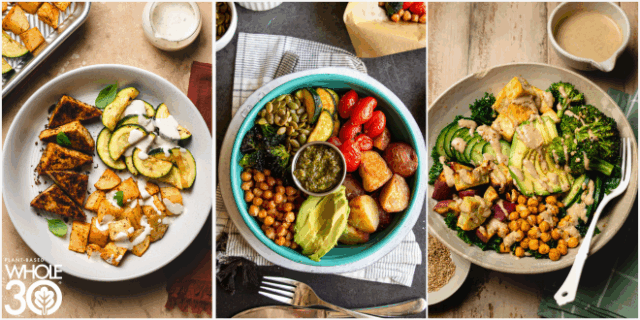While browsing our Plant-Based Whole30 program, you may have noticed recommendations for sprouting beans and lentils before cooking with them. Or, perhaps you’ve noticed recipe creatives like Whole30 Certified Envoys Masala Paleo soaking and sprouting legumes on Instagram. If you’re new to plant-based eating and curious about this practice, you’re in the right place! Registered Dietician Rhyan Geiger has a beginner’s guide to soaking and sprouting beans, lentils, nuts, and seeds. It’s everything you need to know to confidently prepare your plant-based proteins.
Reminder: Beans, lentils, and soy are part of our Plant-Based Whole30 program, designed specifically for those who want to complete our elimination program without consuming any animal products. For more on the differences between the Plant-Based Whole30 and our Original Whole30 program, refer to this article.
Soaking and sprouting legumes, nuts, and seeds increases nutrient availability. This process makes minerals like iron, calcium, and zinc more readily available for absorption. Soaking also makes the plant proteins more available for your body. This process takes a little additional time, but it’s worth it. You’ll get additional nutrients while lessening anti-nutrients, such as phytic acid and tannins, and gas-causing compounds that negatively impact digestion.
How to Soak Beans and other Legumes, Nuts, and Seeds
Soaking is straightforward! It’s exactly what it sounds like: allowing these items to soak in a jar or bowl of water for a specific amount of time before cooking and eating them. Plan ahead and soak your legumes, nuts, and seeds overnight to make meal prep even easier. By the time you wake up, it will be ready to use.
Reference this chart for ideal soaking times:
| Nuts and Beans to Soak | Soaking Time |
| Nuts | |
| Cashews | 2 hours |
| Almonds | 8-12 hours |
| Beans | At least 8 hours, but no more than 24. |
| Black beans | 8-24 hours |
| Garbanzo beans | 8-12 hours |
How to Sprout Beans and Other Legumes, Nuts, and Seeds
Sprouting legumes, nuts, and seeds is a great way to enhance the nutrients in your plant-based meals. There are a variety of different seeds to choose from when sprouting. But some of the most popular are alfalfa and broccoli seeds.
- To sprout legumes and seeds you will start by adding ½ cup dried legumes to a clean, 32-ounce jar. Once your legumes or seeds are in the jar, rinse them with water until the runoff liquid is clear. After the rinse water is clear, you can fill the jar with water. You want to have most of the jar filled with water because the legumes or seeds will expand.
- Now that the seeds or legumes are fully submerged, leave them on the counter and out of direct sunlight for 8-12 hours. Drain and then cover with a breathable cloth.
- Place the jar with the rinsed legumes or seeds back on the counter out of direct sunlight and rinse with cool water and drain each day for 3-4 days. You should notice sprouts on the first 1-2 days. Some people find keeping their jar at a 45-degree angle—with the ability for any access water to run out—useful, as well.
- Once sprouting is complete (after 3-4 days) lay your seeds or legumes on a towel to dry and store them in the fridge for 3 to 5 days.
Sprouting Schedules and Tips
| Seeds to Sprout | Measurement | Soaking Time | Rinsing Time | Harvest Time |
| Alfalfa | 2 tablespoons | 8 hours | 2 to 3 times daily | 5 to 6 days |
| Broccoli | 2 tablespoons | 8 hours | 2 to 3 times daily | 3 to 6 days |
| Kale | 2 tablespoons | 2 to 6 hours | 2 to 3 times daily | 5 to 8 days |
| Legumes to Sprout | ||||
| Mung Beans | ½ cup | 8 hours | 2 to 3 times daily | 3 to 5 days |
| Lentils | ½ cup | 8 hours | 2 to 3 times daily | 2 to 4 days |
| Peas | ½ cup | 8 hours | 2 to 3 times daily | 2 to 3 days |
Sprouts are versatile items in the kitchen. They can be used on almost anything! You can use sprouted items top of soups, salads, or even as a stir-fry topping. Soaked nuts are a great option to make smooth sauces. Since they’re a little crunchy, you’ll be adding a nice texture to meals, too.
PRO Tips
To start sprouting seeds, you first have to buy them! You can buy seeds online or at some local health shops. But ensure your purchases have certification that the seeds were grown safely. Also, tools like a seed sprouter can be useful if you are starting out with sprouting seeds. However, glass jars work just as well. If using a glass jar, here’s what you’ll need per sprouted item:
A (32 ounce) glass jar
1 mesh or cheese cloth
A rubber band
You may also be able to find a sprouting specific lid for glass jars.
When soaking beans, they are best found in the bulk section of grocery stores. That’s where the best prices are, but any dried beans will do! After the beans are soaked, you can add any combination of spice blends to add flavor to your cooking beans.
FAQ for Soaking and Sprouting Legumes
Should I be concerned about lectins and phytates, as well as other ‘anti-nutrients’ in legumes?
Not really. By soaking and sprouting your legumes, it removes many of the anti-nutrient properties. Legumes offer plenty of other health benefits, as well. If lectins and phytates are a concern of yours, Whole30 offers other plans that may be a better option for you.
Can I buy legumes/lentils/nuts/seeds pre-sprouted?
Yes! Depending on your location, you’re able to purchase pre-sprouted seeds and legumes. These can be found in the produce section of grocery stores.
What if soaking and sprouting doesn’t improve my digestion of legumes?
If you notice soaking or sprouting doesn’t help with digestion, it’s always best to consult with your primary care provider. You can also work with a dietitian to identify potential food sensitivities.
What if I soak too long or too little?
If you don’t soak seeds or nuts for long enough, there is a chance you won’t remove the anti-nutrients or get the maximum benefits. It can also have an impact on recipe cook times and texture. Soaking for too long can cause the item to spoil or ferment. When this happens, you’ll notice an acidic or vinegar-like taste.
Are there any food-safety considerations?
Yes. Only for sprouted foods, not soaked. Sprouts grow in a humid and moist environment that’s also ideal environment for some bacteria to grow. Because sprouts are eaten raw or lightly cooked, there may be a higher risk of food-borne illness. Pregnant women, the elderly, and immunocompromised individuals should avoid eating sprouted foods from home and the grocery store.
What are the differences between a shorter soak time (4 hours) and a longer soak time (16 hours)?
Some nuts and beans need shorter periods of time for the enzymes to break down. Each suggested time has a minimum to maximum time. For the best results, don’t go less than the recommended duration and stay under the maximum soak time.















